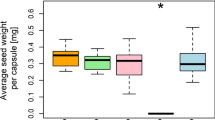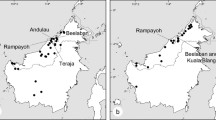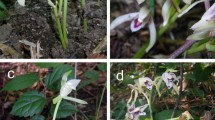Abstract
Polyploidy has played a key role in plant evolution and diversification. Despite this, the processes governing reproductive isolation among cytotypes growing in mixed-ploidy populations are still largely unknown. Theoretically, coexistence of diploid and polyploid individuals in sympatric populations is unlikely unless cytotypes are prezygotically isolated through assortative pollination. Here, we investigated the pre-mating barriers involved in the maintenance of three co-occurring cytotypes from the genus Gymnadenia (Orchidaceae): tetraploid and octoploid G. conopsea and tetraploid G. densiflora. We assessed differences in flowering phenology, floral morphology, and visual and olfactory cues, which could lead to assortative mating. Gas chromatography coupled with electroantennographic detection was used to identify scent compounds with physiological activity in the two main pollinators, Deilephila porcellus and Autographa gamma. The importance of olfactory cues was also assessed in the field by analysing the moths’ responses to the olfactory display of the plants, and by following the pollinator’s behaviour on artificial arrays. Our complex approach demonstrated that the coexistence of Gymnadenia cytotypes in mixed-ploidy populations was only partly explained by differences in floral phenology, as cytotypes with overlapping flowering (i.e., octoploid G. conopsea and tetraploid G. densiflora) might freely exchange pollen due to only 1 mm differences in spur lengths and the lack of assortative behaviour of pollinators. While floral colour among the cytotypes was similar, floral scent differed significantly. Though both pollinator species seemed to physiologically detect these differences, and the floral scent alone was sufficient to attract them, pollinators did not use this cue to discriminate the cytotypes in the field. The absence of pre-mating barriers among cytotypes, except partial temporal segregation, suggests the existence of other mechanisms involved in the cytotypes’ coexistence. The genetic differences in ITS sequences among cytotypes were used to discuss the cytotype’s origin.




Similar content being viewed by others
References
Adams RP (2007) Identification of essential oil components by gas chromatography/mass spectrometry, 4th edn. Allured Publishing Corporation, Carol Stream, Illinois
Aldrich J, Cherney BW, Merlin E, Christopherson L (1988) The role of insertions/deletions in the evolution of the intergenic region between psbA and trnH in the chloroplast genome. Curr Genet 14:137–146
Anderson B, Johnson SD (2009) Geographical covariation and local convergence of flower depth in a guild of fly-pollinated plants. New Phytol 182:533–540
Anderson MJ, Gorley RN, Clarke KR (2008) PERMANOVA + for PRIMER: guide to software and statistical methods. PRIMER-E, Plymouth, UK
Anderson B, Alexandersson R, Johnson SD (2009) Evolution and coexistence of pollination ecotypes in an African Gladiolus (Iridaceae). Evolution. doi: 10.1111/j.1558-5646.2009.00880.x
Arnold SJ, Verrell PA, Tilley SG (1996) The evolution of asymmetry in sexual isolation: a model and a test case. Evolution 50:1024–1033
Barrett SCH, Lloyd DG, Arroyo J (1996) Stylar polymorphisms and the evolution of heterostyly. Narcissus (Amaryllidaceae). Floral biology: studies on floral evolution. In: Lloyd DG, Barrett SCH (eds) Animal-pollinated plants. Chapman and Hall, New York, pp 339–376
Bradshaw HD, Schemske DW (2003) Allele substitution at a flower color locus produces a pollinator shift in two monkeyflower species (Mimulus). Nature 426:176–178
Brantjes NBM (1978) Sensory responses to flowers in night-flying moths. In: Richards AJ (ed) The pollination of flowers by insects. Academic Press, London, pp 13–19
Buser HR, Arn H, Guerin P, Rauscher S (1983) Determination of double bond position in monounsaturated acetates by mass spectrometry of dimethyl disulfide adducts. Anal Chem 55:818–822
Carlsward BS, Whitten WM, Williams NH, Bytebier B (2006) Molecular phylogenetics of Vandeae (Orchidaceae) and the evolution of leaflessness. Am J Bot 93:770–786
Clarke KR, Gorley RN (2006) PRIMER v6: user manual/tutorial. PRIMER-E, Plymouth
Cook LM, Soltis PS (1999) Mating systems of diploid and allotetraploid populations of Tragopogon (Asteraceae). I. Natural populations. Heredity 82:37–244
Coyne JA, Orr HA (2004) Speciation. Sinauer Associates, Sunderland, MA
Dafni A, Kevan PG, Husband BC (2005) Practical pollination biology. Cambridge, Enviroquest
Dobson HEM (2006) Relationship between floral fragrance composition and type of pollinator. In: Dudareva N, Pichersky E (eds) Biology of floral scent. CRC Press, Boca Raton, pp 147–198
Dobzhansky T (1940) Speciation as a stage in evolutionary divergence. Am Nat 74:312–321
Doležel J, Greilhuber J, Suda J (2007) Estimation of nuclear DNA content in plants using flow cytometry. Nat Protoc 2:2233–2244
Dötterl S, Füssel U, Jürgens A, Aas G (2005a) 1, 4-Dimethoxybenzene, a floral scent compound in willows that attracts an oligolectic bee. J Chem Ecol 31:2993–2998
Dötterl S, Wolfe LM, Jürgens A (2005b) Qualitative and quantitative analyses of flower scent in Silene latifolia. Phytochemistry 66:203–213
Dötterl S, Jürgens A, Wolfe LM, Biere A (2009) Disease status and population origin effects on floral scent: potential consequences for oviposition and fruit predation in a complex interaction between a plant, fungus, and noctuid moth. J Chem Ecol 35:307–319
Dunkelblum E, Gothilf S (1983) Sex pheromone components of the gamma moth, Autographa gamma (L.) (Lepidoptera: Noctuidae). Z Naturforsch C 38:1011–1014
Dworschak W (2001) Versuch einer Gliederung der verschiedenen Erscheinungsformen von Gymnadenia conopsea in Südbayern. Ber Arbeitskrs Heim Orchid 18:193–207
Ellis AG, Johnson SD (1999) Do pollinators determine hybridization patterns in sympatric Satyrium (Orchidaceae) species? Plant Syst Evol 219:137–150
El-Sayed AM (2008) The Pherobase: database of insect pheromones and semiochemicals. Available from http://www.pherobase.com
Felber F (1991) Establishment of a tetraploid cytotype in a diploid population: effect of a relative fitness of the cytotypes. J Evol Biol 4:195–207
Felber-Girard M, Felber F, Buttler A (1996) Habitat differentiation in a narrow hybrid zone between diploid and tetraploid Anthoxanthum alpinum. New Phytol 133:531–540
Grant V (1992) Floral isolation between ornithophilous and sphingophilous species of Ipomopsis and Aquilegia. P Natl Acad Sci USA 89:11828–11831
Grant V (1994) Modes and origins of mechanical and ethological isolation in angiosperms. P Natl Acad Sci USA 91:3–10
Gustafsson S, Lönn M (2003) Genetic differentiation and habitat preference of flowering-time variants within Gymnadenia conopsea. Heredity 91:284–292
Halverson K, Heard SB, Nason JD, Stireman JO (2008) Origins, distribution, and local co-occurrence of polyploid cytotypes in Solidago altissima (Asteraceae). Am J Bot 95:50–58
Harder LD, Wilson WG (1998) A clarification of pollen discounting and its joint effects with inbreeding depression on mating system evolution. Am Nat 152:684–695
Heusser C (1938) Chromosomenverhältnisse bei schweizerischen basitonen Orchideen. Ber Schweiz Bot Ges 48:562–605
Howard DJ (1993) Reinforcement: origin, dynamics, and fate of an evolutionary hypothesis. In: Harrison RG (ed) Hybrid zones and the evolutionary process. Oxford University Press, New York, pp 46–69
Howard DJ, Gregory PG, Chu J, Cain ML (1998) Conspecific sperm precedence is an effective barrier to hybridization between closely related species. Evolution 52:511–516
Huber FK, Kaiser R, Sauter W, Schiestl FP (2005) Floral scent emission and pollinator attraction in two species of Gymnadenia (Orchidaceae). Oecologia 142:564–575
Hultén E, Fries M (1986) Atlas of north European vascular plants north of the tropic of cancer, vol 1–3. Koeltz Scientific Books, Königstein, Germany
Husband BC, Sabara HA (2004) Reproductive isolation between autotetraploids and their diploid progenitors in fireweed, Chamerion angustifolium. New Phytol 161:703–713
Husband BC, Schemske DW (2000) Ecological mechanisms of reproductive isolation and coexistence of diploid and tetraploid Chamerion angustifolium. J Ecol 88:689–701
Husband BC, Schemske DW, Goodwillie C, Burton TL (2002) Pollen competition as a unilateral mechanism of reproductive isolation between diploid and tetraploid Chamerion angustifolium. Proc R Soc Lond 269:2565–2571
Johnson SD, Steiner KE (1997) Long-tongued fly pollination and evolution of floral spur length in the Disa draconis complex (Orchidaceae). Evolution 51:45–53
Johnston M (1991) Natural selection on floral traits in two species of Lobelia cardinalis and siphilitica. Evolution 45:1468–1479
Jones CE (1978) Pollinator constancy as a pre-pollination isolation mechanism between sympatric species of Cercidium. Evolution 32:189–198
Jones KN (2001) Pollinator-mediated assortative mating: causes and consequences. In: Chittka L, Thompson JD (eds) Cognitive ecology of pollination: animal behavior and floral evolution. Cambridge University Press, Cambridge, UK, pp 259–273
Kaiser R (1993) Vom Duft der Orchideen. Editiones Roche, Basel
Keeler KH (2004) Impact of intraspecific polyploidy in Andropogon gerardii (Poaceae) populations. Am Midl Nat 152:63–74
Kelber A, Balkenius A, Warrant EJ (2003) Colour vision in diurnal and nocturnal hawkmoths. Integt Comp Biol 43:571–579
Kennedy BF, Sabara HA, Haydon D, Husband BC (2006) Pollinator-mediated assortative mating in mixed ploidy populations of Chamerion angustifolium (Onagraceae). Oecologia 150:398–408
Knudsen JT, Eriksson R, Gershenzon J, Ståhl B (2006) Diversity and distribution of floral scent. Bot Rev 72:1–120
Kron P, Suda J, Husband C (2007) Applications of flow cytometry to evolutionary and population biology. Annu Rev Ecol Evol S 38:847–876
Levin D (1975) Minority cytotype exclusion in local plant populations. Taxon 24:35–43
Lewis WH, Suda Y (1976) Diploids and polyploids from a single species population: temporal adaptations. J Hered 67:391–393
Lexer C, van Loo M (2006) Contact zones: natural labs for studying evolutionary transitions. Curr Biol 16:R407–R409
Lloyd DG, Webb CJ (1986) The avoidance of interference between the presentation of pollen and stigmas in angiosperms. I. Dichogamy. New Zeal J Bot 24:135–162
Lumaret R, Guillerm JL, Delay J, Ait Lhaj Loufti A, Izco J, Jay M (1987) Polyploidy and habitat differentiation in Dactylis glomerata, L. from Galicia (Spain). Oecologia 73:436–446
Marhold K, Jongepierová I, Krahulcová A, Kučera J (2005) Morphological and karyological differentiation of Gymnadenia densiflora and G. conopsea in the Czech Republic and Slovakia. Preslia 77:159–176
Mazor M, Dunkelblum E (1992) Role of sex pheromone components in behavioral reproductive isolation between Autographa gamma (L.) and either Trichoplusia ni (Hübner) or Chrysodeixis chalcites (Esp.) (Lepidoptera: Noctuidae: Plusiinae). J Chem Ecol 18:2373–2384
Meagher RL (2002) Trapping noctuid moths with synthetic floral volatile lures. Entomol Exp Appl 103:219–226
Moccia MD, Widmer A, Cozzolino S (2007) The strength of reproductive isolation in two hybridizing food-deceptive orchid species. Mol Ecol 16:2855–2866
Nilsson LA (1983) Processes of isolation and introgressive interplay between Platanthera bifolia (L.) Rich. and P. chlorantha (Custer) Reichb. (Orchidaceae). Bot J Linn Soc 87:325–350
Nilsson LA (1988) The evolution of flowers with deep corolla tubes. Nature 334:147–149
Nuismer SL, Cunningham BM (2005) Selection for phenotypic divergence between diploid and autotetraploid Heuchera grossulariifolia. Evolution 59:1928–1935
Petit C, Lesbros P, Ge X, Thompson JD (1997) Variation in flowering phenology and selfing rate across a contact zone between diploid and tetraploid Arrhenatherum elatiius. Heredity 79:31–40
Plepys D, Ibarra F, Löfstedt C (2002) Volatiles from flowers of Platanthera bifolia (Orchidaceae) attractive to the silver Y moth, Autographa gamma (Lepidoptera: Noctuidae). Oikos 99:69–74
Raguso RA, Light DM (1998) Electroantennogram responses of male Sphinx perelegans hawkmoths to floral and ‘green-leaf volatiles’. Entomol Exp Appl 86:287–293
Raguso RA, Willis MA (2005) Synergy between visual and olfactory cues in nectar feeding by wild hawkmoths, Manduca sexta. Anim Behav 69:407–418
Raguso RA, Light DM, Pichersky E (1996) Electroantennogram responses of Hyles lineata (Sphingidae: Lepidoptera) to volatile compounds from Clarkia breweri (Onagraceae) and other moth-pollinated flowers. J Chem Ecol 22:1735–1766
Rieseberg LH, Willis JH (2007) Plant speciation. Science 317:910–914
Rieseberg LH, Desrochers AM, Youn SJ (1995) Interspecific pollen competition as a reproductive barrier between sympatric species of Helianthus (Asteraceae). Am J Bot 82:515–519
Riffell JA, Alarcon R, Abrell L, Davidowitz G, Bronstein JL, Hildebrand JG (2008) Behavioral consequences of innate preferences and olfactory learning in hawkmoth-flower interactions. P Natl Acad Sci USA 105:3404–3409
Schiestl FP, Marion-Poll F (2001) Detection of physiologically active flower volatiles using gas chromatography coupled with electroantennography. In: Jackson JF, Linskens HF, Inman RB (eds) Molecular methods of plant analysis, 21: analysis of taste and aroma. Springer, Berlin, pp 173–198
Segraves KA, Thompson JN (1999) Plant polyploidy and pollination: floral traits and insect visits to diploid and autotetraploid Heuchera grossulariifolia. Evolution 53:1114–1127
Selosse MA, Bauer R, Moyersoen B (2002) Basal hymenomycetes belonging to the Sebacinaceae are ectomycorrhizal on temperate deciduous trees. New Phytol 155:183–195
Shaw J, Lickey EB, Schilling EE, Small RL (2007) Comparison of whole chloroplast genome sequences to choose noncoding regions for phylogenetic studies in angiosperms: the tortoise and the hare III. Am J Bot 94:275–288
Soltis DE, Albert VA, Leebens-Mack J, Bell CD, Paterson AH, Zheng C, Sankoff D, dePamphilis CW, Wall PK, Soltis PS (2009) Polyploidy and angiosperm diversification. Am J Bot 96:336–348
Stahlberg D (2009) Habitat differentiation, hybridization and gene flow patterns in mixed populations of diploid and autotetraploid Dactylorhiza maculata s.l. (Orchidaceae). Evol Ecol 23:295–328
Stebbins GL Jr (1950) Variation and evolution in plants. Columbia University Press, USA
Taberlet P, Gielly L, Pautou G, Bouvet J (1991) Universal primers for amplification of three non-coding regions of chloroplast DNA. Plant Mol Biol 17:1105–1109
Thompson JN, Merg KF (2008) Evolution of polyploidy and diversification of plant-pollinator interactions. Ecology 89:2197–2206
Tothill JC, Hacker JB (1976) Polyploidy, flowering phenology and climatic adaptation in Heteropogon contortus (Gramineae). Aust J Ecol 1:213–222
Vamosi JC, Goring SJ, Kennedy BF, Mayberry RJ, Moray CM, Neame LA, Tunbridge ND (2007) Elle E (2007) Pollination, floral display, and the ecological correlates of polyploidy. Funct Ecosyst Commun 1:1–9
van Dijk P, Bijlsma R (1994) Simulations of flowering time displacement between two cytotypes that form inviable hybrids. Heredity 72:522–535
Vöth W (2000) Gymnadenia, Nigritella und ihre Bestäuber. J Eur Orchid 32:547–563
Vöth W, Sontag S (2006) Die intraspezifischen Varietäten der Gymnadenia conopsea (L.). R Br J Eur Orchid 38:581–624
Waser NM (1986) Flower constancy: definition, cause and measurement. Am Nat 127:593–603
Watts CD, Fisher AE, Shrum CD, Newbold WL, Hansen S, Liu C, Kelchner SA (2008) The D4 Set: primers that target highly variable intron loops in plant chloroplast genomes. Mol Ecol Resour 8:1344–1347
Young HJ (2008) Selection on spur shape in Impatiens capensis. Oecologia 156:535–543
Acknowledgments
We thank I. Jongepierová for locating plant populations, F. Schiestl for helpful comments, A. Kelber for advises on moth vision and S.-L. Steenhuisen for English corrections. We also thank two anonymous reviewers for their helpful suggestions improving the manuscript. The work was financially supported by the GA ASCR No. KJB600870601 to J.J., MSM 6007665801 to the Faculty of Science of University of South Bohemia and the Portuguese Foundation for Science and Technology (SFRH/BPD/41200/2007) to S.C.
Author information
Authors and Affiliations
Corresponding author
Electronic supplementary material
Below is the link to the electronic supplementary material.
Rights and permissions
About this article
Cite this article
Jersáková, J., Castro, S., Sonk, N. et al. Absence of pollinator-mediated premating barriers in mixed-ploidy populations of Gymnadenia conopsea s.l. (Orchidaceae). Evol Ecol 24, 1199–1218 (2010). https://doi.org/10.1007/s10682-010-9356-7
Received:
Accepted:
Published:
Issue Date:
DOI: https://doi.org/10.1007/s10682-010-9356-7




